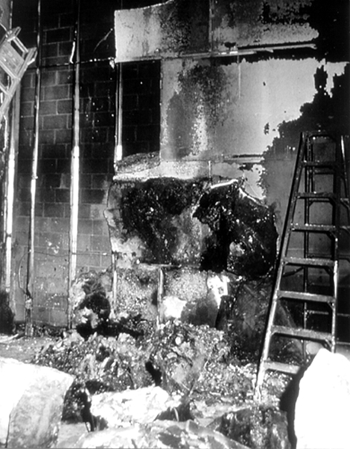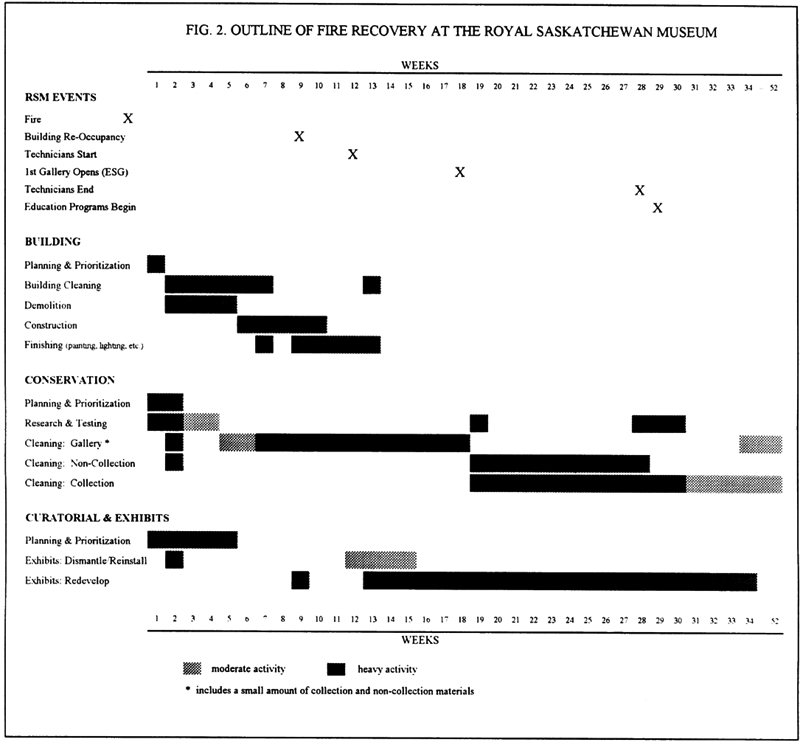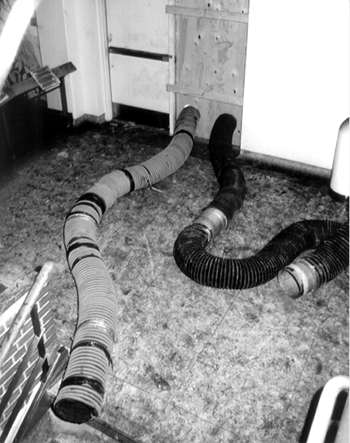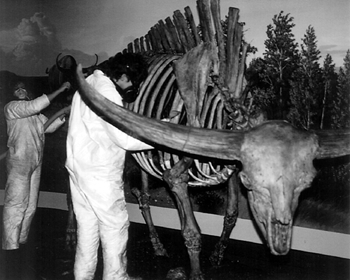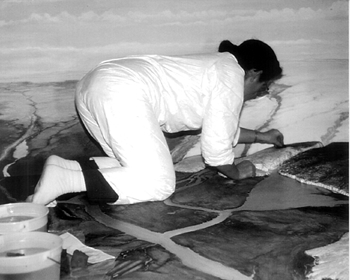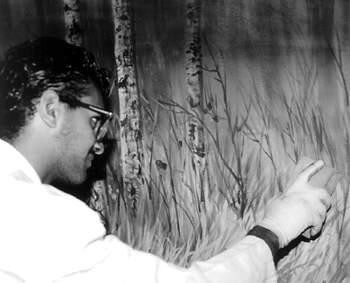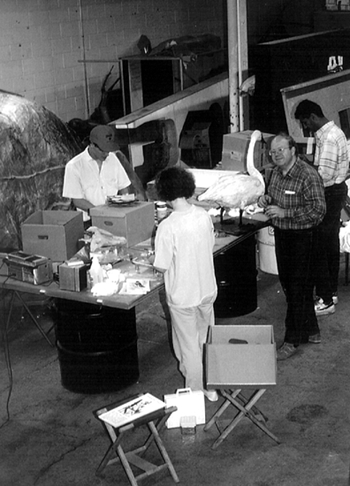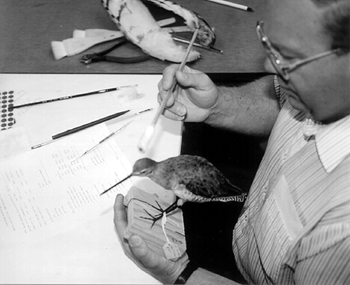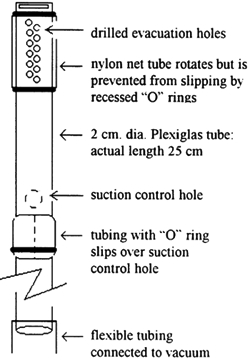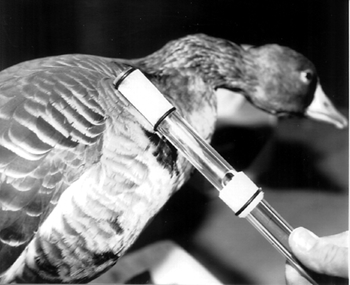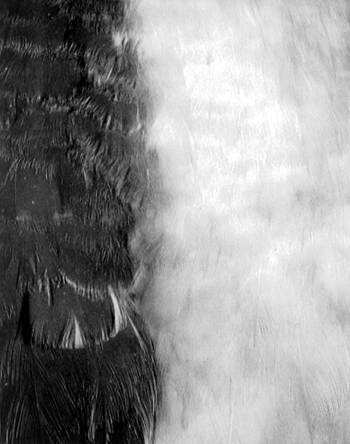THE FIRE AT THE ROYAL SASKATCHEWAN MUSEUM, PART 2: REMOVAL OF SOOT FROM ARTIFACTS AND RECOVERY OF THE BUILDINGSARAH SPAFFORD-RICCI, & FIONA GRAHAM
ABSTRACT—ABSTRACT—In 1990 the Royal Saskatchewan Museum in Regina, Canada, suffered a massive fire, resulting in a heavy deposition of soot throughout the museum. The fire recovery involved the interdependent recoveries of the museum building, the museum's public profile and programs, and the collection and noncollection material. The steps in the building recovery were well defined and involved the coordination of cleaning of the building by a commercial cleaning company, with demolition, reconstruction, and restoration by building trades. Cleaning of soot-covered collection and noncollection museum material was carried out in the museum building (while the building was being restored) and in a warehouse. Soot removal involved conventional conservation cleaning techniques and “bulk” cleaning methods. Conservators identified the unique characteristics of soot and developed guidelines for the removal of soot from museum objects utilizing a strict method of progressive cleaning: direct vacuum, followed by dry-surface-cleaning, and then the careful application of wet-cleaning. TITRE—L'incendie au Royal Saskatchewan Museum, 2e partie: �limination de la suie recouvrant les objets de la collection et sauvetage au niveau de l'�difice. R�SUM�—En 1990, un incendie majeur au Royal Saskatchewan Museum (Mus�e royal de la Saskatchewan), situ� � R�gina, Canada, causa le d�p�t d'une �paisse couche de suie � travers tout le mus�e. Le sauvetage suite � ce sinistre consista en fait � des sauvetages interd�pendants: celui de l'�difice, des programmes et de l'image publique du mus�e, des collections, ainsi que des possessions mat�rielles du mus�e autres que ses collections. Les �tapes du sauvetage de l'�difice �taient bien d�finies et inclurent la coordination des activit�s de nettoyage de l'�difice effectu�es par une firme commerciale sp�cialis�e � cet effet, avec les activit�s de d�molition, de reconstruction et de restauration de l'�difice, r�alis�es par des entrepreneurs en construction. Le nettoyage de la collection et des autres possessions du mus�e, toutes deux recouvertes de suie, eut lieu � l'int�rieur du mus�e pendant m�me que l'�difice �tait restaur� et aussi dans un entrep�t. L'�limination de la suie fut r�alis�e au moyen de m�thodes conventionnelles et aussi au moyen de m�thodes [en masse]. Les restaurateurs identifi�rent les propri�t�s uniques de la suie et d�velopp�rent des lignes directrices pour l'�limination de la suie recouvrant les objets du mus�e en faisant appel � un nettoyage strictement progressif : le d�poussi�rage � l'aspirateur, suivi d'un nettoyage superficiel � sec, et ensuite, avec pr�cautions, d'un nettoyage aqueux. TITULO—El Incendio del Museo Real de Saskatchewan, Parte II: Recuperaci�n del edificio y remoci�n de holl�n de objetos de la colecci�n. RESUMEN—En 1990 el Museo Real de Saskatchewan en Regina, Canad� sufri� un incendio masivo que cubri� de holl�n todo el Museo. El rescate involucr� la recuperaci�n interdependiente del edificio del Museo, sus programas y perfil p�blico, la colecci�n y otros materials del Museo que no forman parte la colecci�n. Los pasos seguidos para la recuperaci�n del edificio estuvieron muy bien definidos e incluyeron la coordinaci�n de la limpieza del edificio por parte de una compa�ia comercial de limpieza con los trabajos de demolici�n, reconstrucci�n y restauraci�n realizados por empresas constructoras. La limpieza de la colecci�n, cubierta de holl�n, as� como otros materiales del museo fu� llevada a cabo en el mismo edificio del Museo (mientras estaba siendo restaurado) y en un dep�sito. La remoci�n del holl�n involucr� t�cnicas convencionales de conservaci�n para la limpieza as� como m�todos de limpieza masiva. Los conservadores identificaron las caracter�sticas espec�ficas del holl�n y desarrollaron lineamientos para su remoci�n de los objetos utilizando un estricto m�todo de limpieza progresiva: aspirado directo, seguido por una limpieza en seco de la superficie y por �ltimo un cuidadosa aplicaci�n de limpieza h�meda. 1 1. INTRODUCTIONThe fire at the Royal Saskatchewan Museum (RSM) on February 16, 1990, was a disaster of massive proportions (fig. 1). The recovery involved not only the collection but also the rehabilitation of the museum's building and furnishings, its educational programs, and its public image. The museum had no disaster plan and was completely unprepared. In the days immediately following the fire, the initial response phase, priorities were established and decisions made that charted the entire course for collection recovery. These factors and the first two weeks of disaster response after the RSM fire are analyzed in a companion article in this issue (Spafford-Ricci and Graham 2000).
Following the RSM fire, the entire building and contents required a tremendous amount of cleaning and restoration. The recovery progressed in two interdependent and sometimes conflicting recovery paths—that of the building and administrative furnishings and that of the museum-owned collection and noncollection material. The building restoration was fueled by insurance money and supervised by persons experienced in disaster recovery; on the other hand, the recovery of the collection and the museum's property was primarily reactive and slowed by delays in obtaining funding and technical assistance. The construction manager oversaw the building construction and cleaning trades, and the senior conservator scheduled the recovery of the museum collection. The staff conservators were made responsible for cleaning all collection and noncollection museum material. The museum cleanup committee, under some pressure from the government department in charge of the museum, decided that the most urgent requirement was to open the facility as quickly as possible to restore public programs and a public “face.” The building restoration group wished to complete its work as quickly as possible and had the mandate to do so under the building's insurance coverage. The building and its contents would therefore receive priority. The galleries that could be opened earliest, and the artifacts on display in these galleries, were to be salvaged and cleaned first. Next in order of importance were educational and research material so that the museum education programs could be restarted. The artifacts removed from damaged galleries that were slated for renovation and the remainder of the collection in storage were scheduled last for cleaning, since there was no “urgent need” for these materials in the museum's programs. 2 2. FIRE RECOVERYA simplified timeline of the overall recovery by the major players—the building restoration group, the conservation group, and the curatorial and exhibits areas—is shown in figure 2. This figure illustrates that building cleanup and restoration, which were covered by insurance and assigned to outside firms, began almost immediately after the fire and proceeded unimpeded until it was completed. On the other hand, the museum collection proceeded without a plan, and these recovery activities had to be arranged around the rigid schedule for building recovery. Collection recovery was postponed by the cleanup and refurbishment of the building and by a slow bureaucratic response to recovery, which resulted in staffing delays. The bulk of collection recovery by conservators was further slowed by the necessity to clean a gallery (which included some collection material, but primarily exhibits and replicas) for museum reopening and by the necessity to clean educational and related noncollection museum material to reestablish educational and public programming. Recovery of the collection was able to proceed in earnest after the museum reopened one gallery, but slowed significantly when the fire recovery contract workers left. Although there were still some hundred heavily damaged natural history specimens remaining to be cleaned after week 52, the museum had run out of funds and resources to continue with the cleaning, and the fire recovery was halted.
2.1 2.1 RECOVERY OF THE BUILDINGThe RSM museum building was owned and managed by a landlord—a government of Saskatchewan property management corporation, which carried private insurance on the building and furnishings. The landlord's project manager, the corporation's insurance adjuster, and a construction manager hired by the insurance adjuster formed a building recovery group and set a plan and schedule for the restoration of the building. The damage to the interior of the blackened museum building was extensive, although there was little structural damage. The landlord and the insurance adjuster entered into meetings with the museum's original architectural and design firm to analyze details of the museum's structure. The entire building—lobby, auditorium, galleries, and public and office areas—would require thorough cleaning to all surfaces, furnishings, and administrative contents (e.g., furniture, window coverings, files). Of the galleries, the Earth Sciences Gallery, which had been open for only eight months, would require substantial attention: cleaning, new finishings (ceiling tiles, carpet, wall coverings, painting, lighting fixtures, etc.) and preparation for the replacement of exhibit items. In the First Nations Gallery, the gallery under construction where the fire had started, one-third would have to be demolished and reconstructed and prepared for replacement of backdrops and other exhibit materials by museum staff. On the upper level, the Life Sciences Gallery would be dismantled by museum staff, and then the room would be cleaned and restored by building trades to await gallery redevelopment. The work of the building cleaners and construction trades (e.g., carpenters, painters, electricians, and drywallers) was overseen by the construction manager, who was answerable to the landlord and the insurance adjuster. The insurance adjuster hired the construction manager because of the large and complex nature of the recovery work and the unusual design of the interior of the building. The use of an on-site manager allowed better cost control over the project and ensured quality of work by trades and consistent organization. From the museum's point of view, the presence of a single person responsible for the building recovery had a positive impact on communication between the museum cleanup crews and the building recovery trades. The museum did, however, learn that it could direct the activities of the trades only through the construction manager, since the trades were not responsible to the museum. The construction management company was compensated by the insurance companies for management services with a payment of 10% of the cost of the trades and “cost plus” for construction work carried out. Specifications for the work were written by the landlord, the insurance adjuster, and the construction manager directly following the fire, while museum staff members were still acquainting themselves with the disaster. The museum cleanup committee was able to add specifications regarding the disclosure of materials used in cleaning and renovation (this is normally a standard specification in nonmuseum disaster recoveries as well) and additional specifications to ensure that collections and exhibits would not be harmed chemically or physically by the actions of the cleaners and trades. The importance of these hurriedly written specifications was enormous. As the construction manager noted: “The trades can't spend a dime above bid without approval. They do no more and no less than specified. If the specifications are not specific enough, then you can get into trouble with the increased possibility of inadequate work done” (Johns 1991). The hiring of specific finishing trades was tendered during the first few weeks as the scope of work became known. Price was the overriding factor in the adjuster's selection of favored companies, but the landlord had final say over the final selection of the contractors. The cleaners and trades were kept to a strict schedule to maintain the pace of cleaning and restoration. Miscellaneous work, such as the building of temporary walls during the building cleaning, was done by the construction firm headed by the construction manager. The trades and the construction manager were dependent upon the curators, the exhibits department, and the maintenance department to present exhibit plans and explain details relating to the construction and finishing of the museum. The staff found researching this information very difficult, since some of the information was not recorded and some was contained in sooty files that had been taken off-site for cleaning. At several points during the recovery of the building, the building recovery group and museum cleanup committee searched for pockets of soot that they could smell but not see. Some of this soot was found trapped between walls erected during years of gallery and museum renovations that were undocumented. On the seventh day after the fire, the cleaning company descended upon the building in a large crew of approximately 30 workers who worked double shifts and were on site for approximately 16 hours a day. The cleaners followed standard procedures using cleaning materials and sealants designed for building restoration. The various stages of building cleanup were dovetailed with the activities of the building trades (who were contracted for various aspects of refurbishment and reconstruction of the building) in a carefully planned schedule that was overseen by the landlord's construction manager. The manager communicated with the head of the museum cleanup committee, who then coordinated the conservators' collection recovery activities around the building cleaners. In accordance with standard procedure in the disaster restoration-commercial cleaning industry, the cleaning and refurbishment took place in three general stages. During the first stage of cleaning, all extremely sooty elements (e.g., suspended ceiling tiles) or nonrecoverable building features (e.g., the entire diorama area at the burn site) were removed and discarded. Temporary walls were built at the entry and exit to the galleries to control airflow, and large vacuum hoses were installed to allow for connection to high-powered vacuum compressors mounted outdoors on trucks (fig. 3). All surfaces were cleaned of loose soot, using the vacuums along with brushes and brooms. Ductwork was cleaned by dragging the vacuum hoses through the ducts. When not otherwise in use, the powerful vacuums were left running to draw loose soot from the air and to create a negative pressure in the dirty areas.
During the second pass, when all demolition had ceased, reconstruction of damaged areas of the building by the construction trades began. Meanwhile, the cleaners carried out a thorough washing and scrubbing of all areas, using cleaning materials designed for fire-damaged buildings. For nonporous surfaces, they used strong detergents in water, primarily a product called GP-2000. Soot-removal sponges were dragged across porous sooty surfaces such as wood and unpainted drywall; soot was absorbed into the rubber sponges and rolled off with the crumbs. The next step in the process was to apply sealant to areas such as ductwork, crawl spaces, and drywall that could not be cleaned or could be only partially cleaned. All of these surfaces received a spray coat of a heavy-bodied oil paint, brand name Kilz, to seal in soot particles and soot smell (fig. 4). The application of this sealant preceded any painting and finishing work. Following the application of this sealant, the walls were painted and new ceilings, carpets, and floors were installed.
The last cleaning pass involved a thorough cleaning and polishing. After a final inspection, the building was turned over to museum staff for reoccupancy. By May 28, 1990, the reconstruction and cleaning of the building were completed; on June 23, four months and seven days after the fire, one of the four gallery spaces in the museum was opened to the public. 2.2 2.2 RECOVERY OF MUSEUM EXHIBITS AND PROGRAMSFollowing the fire at the RSM, the museum building was boarded up and “out of business.” The administrative, education, and gift shop staff were relocated to other buildings. Staff members moved off-site, and their projects came to a virtual standstill until files and computers were cleaned and returned to them. They did not return to their offices until nine weeks later. Regular administrative and management activities, including a proposal to the government for museum redevelopment, were shelved to undertake the imperative demands of the fire recovery. The two-week response period immediately following the fire was one of heightened emotions and rushed meetings. It was decided that all artifacts would have to stay in the building during the recovery because it would be impossible to move them before the building cleaning company moved in. The artifacts on display were deemed immobile because they were large, semipermanently mounted, or enclosed within display cases. Museum staff and volunteers did, however, move all administration and program contents (files, educational material, resource library, etc.) to off-site storage areas for further cleaning. Within the first week following the fire, these items were quickly packed into boxes that were stacked by the hundreds on shelves hastily erected in the museum hallways; later the boxes were removed by a moving company to temporary offices and warehouses. In some cases, staff members cleaned soot from their own files and administrative materials, a task that took a significant amount of time from their schedules. Due to a lack of funds for recovery, some files and other administrative material could not be cleaned and were discarded. The museum administration was completely unprepared for the emergency and did not have a disaster plan. The areas of communications, hiring, and large budget expenditures were normally managed by other government departments, and the wheels of bureaucracy turned slowly in these vital areas. Without the benefit of a disaster plan, which would have outlined a plan and personnel for communications, the museum was unable to implement any effective communications measures. The gift shop inventory was badly damaged, and most of it was discarded. Gift shop staff and volunteers spent the recovery time restocking the gift shop and directing the restoration of the gift shop areas. Education staff members were forced to cancel educational programming well past the time that the museum reopened, as they awaited first the restoration of the educational rooms and then the cleaning of the educational materials (deaccessioned artifacts and teaching aids). With the aid of volunteer docents, the education department was able to take a modified education program into local schools. Educational programming in the museum itself did not resume until seven months after the fire. The museum management and curatorial staff devoted an enormous amount of time investigating the building's architectural and design features for rehabilitation of the building and attending meetings with government officials. The exhibit staff, and to a lesser extent the curatorial staff, had to fit previously planned projects around the work of rehabilitating the museum's exhibits. Exhibit staff disassembled and reassembled dioramas and displays for cleaning in the sooty Earth Sciences Gallery and researched the materials required for restoring the gallery area (paint colors, carpets, lighting, etc.). Large areas of the First Nations Gallery required redesign and reconstruction by the exhibit staff. Gallery redevelopment schedules were extended because staff members were not only required to redevelop existing exhibits but also lost the ability to work on regularly scheduled gallery redevelopment projects. The government offered the museum very little in the way of new money for recovery, and its position was reflected in diminished funds for the museum's gallery redevelopment and further delays in the redevelopment schedule. The Life Sciences Gallery, the last gallery to be restored after the fire, is currently being redeveloped and is expected to reopen in 2001. 2.3 2.3 RECOVERY OF THE MUSEUM AND COLLECTIONThe museum was self-insured by the government and therefore was responsible for recovery of the collection, educational materials, and displays. The museum could not afford to hire a commercial cleaning company to clean noncollection museum material (such as replicas, dioramas, and display material), leaving the staff conservators with responsibility for cleaning this material as well as the collection. Although the cleaning of noncollection materials was an enormous task, it provided an opportunity for the conservators to develop procedures for soot removal that could be used for cleaning the collection later in the recovery phase. Before the building cleaners undertook their first pass, they were asked to complete the first and second cleaning passes in the washrooms and in three rooms that could be used as “clean rooms” for the museum's recovery activities. One of these rooms (the museum boardroom) was used to store kits of soot cleanup clothing and cleaning materials and supplies and was also used as a staff room and change room. The second and third rooms were designated to receive the first of the salvaged displays and artifacts that would be removed from storage and exhibit areas. In most cases, this salvage included direct application of a vacuum cleaner nozzle to remove soot before the objects were handled. These displays and specimens were moved back into place after the building cleaners and the building trades had completed cleaning of the rooms and galleries. Since conservation cleaning was undertaken in the building while it was being cleaned and restored, careful attention was required to protect uncleaned artifacts and displays. Before demolition and building cleanup, artifacts and displays were protected with draping of polyethylene film and by temporary plywood barriers. The protective draping was replaced as each area was cleaned at the end of each day to minimize soot and construction products from the air landing on the cleaned surfaces. The museum recovery effort required careful organization. The work was carried out by a crew composed of the two staff conservators, other staff members as they were available (one permanent assistant was assigned from the exhibit staff), four technical staff (hired three months after the fire), and several volunteers. They worked in many locations throughout the museum and in a warehouse. A master binder with test results was stored in the lobby, and short, written procedures were posted to aid technicians and volunteers. Conservators made concise notes on the materials, methods, and time that were taken for each object or area being recovered and for each refurbishment project and kept a daily log of overall recovery activities that were taking place. Volunteers logged their hours and duties on a sign-in sheet in the lobby. The conservators came to rely on a portable chart noting what objects and areas had been cleaned, or partially cleaned, at the end of each day, since the work often had to be abandoned to make way for commercial cleaners or construction workers and then resumed some days later. Fire cleanup gear was kept in the staff meeting–changing room. Table 1 lists the basic supplies that were used by conservators during the fire recovery. Requisite fire cleanup clothing for the commercial cleaners and for museum workers was white disposable coveralls. Although an air analysis performed the third day following the fire revealed the presence of no toxic substances, some cleaners chose to wear solvent vapor masks in the early part of the recovery, but later only particulate masks were used. It was necessary to wear old shoes and clothing, since after only one day they would become blackened and take on a bitter soot smell that could not easily be removed. Cleaning supplies and equipment were kept in this room and in other small locked closets as closets were cleaned and readied by the commercial cleaners. Smaller quantities of supplies were kept in plastic carry kits and on carts so that they could be used in various parts of the museum.
2.3.1 2.3.1 Cleaning Collection and Noncollection MaterialsThe museum conservators began to conduct cleaning tests on the fourth day following the fire, using portable lights to compensate for the lack of lighting and a kit consisting of cleaning tools, prepared solutions, and dry surface cleaners. They also carried with them a chart to document test results and estimate the time that would be required for each area. The extent of the spread of the soot was astonishing. Soot was everywhere, on horizontal surfaces as well as on ceilings and walls. It had penetrated every hairline opening into display cases and inside drawers and cabinets. On some surfaces the soot had deposited evenly with an almost undetectable pigmentation, making an assessment of the damage even more complicated. In these instances, the presence of the thinner layers of soot could only be detected using a finger, a wad of Groom/Stick, or an absorbent cotton pad. Bird specimens, stored in closed cabinets far from the fire, often did not appear sooty, but, when they were removed, clean areas remained on the shelves. The sprinkling of soot on the shelves became a gray oily smear when a finger was dragged over the surface. The conservators decided to clean all artifacts and displays, even those with very little detectable soot. The decision turned out to be a wise one since the cleaning led to a much brighter overall appearance, even when the soot was barely detectable on the surface. Samples of soot from various parts of the museum were sent to the Canadian Conservation Institute for analysis (CCI 1990). Scientists analyzed the soot using Fourier transform infrared spectroscopy (FTIR) and found that all the samples had identical FTIR spectra. The soot was comprised primarily of carbon with some oily or tarry pyrolysis products from the polyester (fiberglass resin) and some pyrolysis products from the polyurethane (insulation foam) absorbed onto the carbon. When a sample of soot was clamped between filter papers, no exudation from the soot was noted, but soot particles became entrapped in the fibers of the paper. Aqueous extracts of the soot were acidic between pH 4 and 4.5. Under the microscope, the soot was seen to be in the form of different size agglomerations. These aggregates had been segregated due to flotation effects, finer particles being located farther from the fire and inside museum cases. Organic solvents (e.g., hexane and acetone) were found to extract from the soot yellow oily components containing esters, aromatic benzene rings (and perhaps polynuclear aromatics), and long-chain alkyl groups. The soot was easily wetted by these solvents and dispersed well but settled quickly. Water did not wet the soot and extracted nothing. Soot analysis carried out by CCI indicated that mechanical and dry methods promised the best cleaning results and that surfactants would be required if aqueous solvents were used. Organic solvents, which would extract colored products, were to be avoided if possible. Practical on-site cleaning tests by RSM conservators confirmed these findings. The conservators' first assignment was to clean one gallery (the Earth Sciences Gallery) so that the museum could reopen as quickly as possible. On the third week following the fire, building cleaners had completed their first and second cleaning passes, and it was possible for the conservation crew to begin the tedious task of cleaning all of the collection and display material in the gallery (fig. 5). Portable lights were still required during the cleaning because lighting could not be installed until after construction in the gallery was completed. Installation of lighting fixtures was one of the last stages of the construction.
The procedures used in cleaning the Earth Sciences gallery became the basis for the development of procedures for soot removal that were used throughout the recovery. Although different surfaces responded very differently to cleaning depending on the degree of soot coverage and the material the artifact was made of, all surfaces responded best to a strict progressive cleaning procedure that involved direct vacuum (which had already been done during initial salvage but was often repeated again in recovery to remove more soot), dry-surface-cleaning techniques, and then wet-cleaning, if necessary. For example, a painted acrylic canvas backdrop marouflaged to Gyproc board was cleaned by direct vacuuming (twice); then soot sponges were used to pull off almost all of the remaining soot, and wet-cleaning was not necessary. A glacier exhibit constructed of varnished acrylic paint on a canvas backdrop and a molded plastic base was cleaned by direct vacuum followed by the use of soot sponges and wet-cleaning with 1% ammonium hydroxide in water applied on sponges with a water rinse to the backdrop (fig. 6). A fossil concretion received two direct vacuums (the second using an attachment of a thin plastic tubing to reach into interstices), was dry-surface-cleaned with Groom/Stick applied by hand and on the end of a paintbrush, and then required wet-cleaning using 2% Orvus (v/v) foam on swabs with a water rinse (fig. 7).
In general, vacuuming and dry-surface-cleaning removed the largest quantities of soot, and wet-cleaning (normally detergent or surfactant in water) was used sparingly to remove the soot that was intricately tied with the surface. “Bulk” cleaning techniques were used in some circumstances. Large amounts of plastic foliage in dioramas were removed, placed in the back of a truck, and put through a commercial car wash. Other foliage was hand dipped and sponged in large plastic garbage cans filled with a dilute solution of Orvus in water, and then rinsed. Replica tree trunks were cleaned out of doors using Orvus in water and a garden hose. The 7,800 sq. ft. Earth Sciences Gallery was recovered in 93 days; this aspect of the project involved cleaning the gallery, displays, and artifacts, painting the gallery walls, and replacing some exhibit and nonexhibit elements, such as ceiling, carpet, and lighting fixtures. Table 2 summarizes some of the materials that were used to clean various surfaces. Table 3 compares the treatment time required for displays of various museum objects.
After technical staff were hired, it was possible to expand the museum recovery efforts to other areas of the gallery and into warehouses and to begin cleaning the noncollection material that had been removed from the building. Cleaning took place in the First Nations Gallery on those displays that would not be replaced. In one case, a diorama backdrop near the fire was thoroughly cleaned with direct vacuum and soot sponges (fig. 8). The lower half, which was only moderately sooty, was solvent-cleaned using 2% ammonium hydroxide in water applied on sponges with a water rinse. The upper half, which was black with soot, was washed down with paint thinner on sponges and then prepared with layers of gesso for repainting by the artist. Foreground material was removed from the Life Sciences Gallery in countless trips using wheelbarrows to discard the material outside. The stripped dioramas were left with sooty animals and backdrops, which were cleaned with the direct application of a vacuum nozzle until they could be cleaned more thoroughly.
Boxes of education material and other items were cleaned by technicians in an off-site warehouse (fig. 9). To remove soot from these noncollection materials, bulk cleaning treatments were carried out, involving the use of conservation and household cleaning materials. All objects were first vacuumed and then cleaned in the quickest possible fashion. For example, paper objects were cleaned in a tray holding a small layer of eraser powder so that the objects could be rubbed with the powder in assembly-line fashion, and then removed from the tray so that the powder could be brushed and vacuumed away.
A much-used resource library was also cleaned. Technical staff were shown how to clean the limited variety of surfaces and proceeded in an assembly-line fashion. Due to the tight packing of books on the shelves, soot had not generally filtered between the pages. Book covers were direct-vacuumed, and then the text blocks were vacuumed while holding the covers tightly to avoid soot penetration into the pages. Dry-surface-cleaning techniques were then applied: the text block was cleaned with erasers or soot sponges, and the cover was wiped with Webril Wipes or soot sponges. Small pamphlets were direct-vacuumed and then carefully cleaned by rubbing with eraser powder in a shallow plastic tray or paint tray that held a small amount of eraser powder. The powder was then brushed and vacuumed away. 2.3.2 2.3.2 Removal of Soot from BirdsThe bird mount collection of 1,500 specimens, stored in closed cabinets in rooms far from the fire, had only a dusting of soot. The birds were cleaned using a variety of tools, but time constraints precluded use of vacuum in most cases. Wood bases were cleaned with a Hake brush, soot sponge, and Groom/Stick. Using an old taxidermy trick, an owl wing was waved through the air in a whisking motion to blow loose particles free from feathers. The owl wing was then brushed gently over the surface of the object. Webril Wipe, cut into 1 in. wide strips, was rolled several layers thick onto a wooden stick and brushed gently over the feathers. Soiled Webril was removed one layer at a time (fig. 10). Tweezers and dental tools were used for some feather realignment. Eyes, feet, and legs were cleaned as needed with Groom/Stick, ethanol, 2% Orvus (v/v) in a water rinse, or distilled water.
Bird and animal mounts on display in the RSM upper-level Life Sciences Gallery were covered with a heavy soot layer. Extensive cleaning tests were done in the conservation laboratory, and results were evaluated by visual examination through a binocular operating microscope. Under microscopic examination, it was evident that the intricate structure of the feathers had trapped soot on the surface, between the barbules of the top feathers. In some cases, the soot had migrated through the uppermost feather mat onto feathers below. To avoid breaking up soot agglomerations and driving soot deep into the feather mat, a Plexiglas wand vacuum nozzle was developed. The design of the wand was based on the design of a dental evacuator that had been reported in the literature for the effective cleaning of feathers (Green and Storch 1982). The wand, shown in figure 11, was constructed from a hollow Plexiglas cylinder capped at the top end with a piece of Plexiglas. The cylinder has two rows of extraction holes drilled along the side of the wand near the tip, allowing free movement over curved parts of birds of any size. A piece of nylon butterfly-net fabric was welded into a tube using a hot point slipped over the wand, positioned between two recessed rubber O-rings. The netting rotates freely over the extraction holes to prevent feathers from being drawn into the wand holes. The bottom of the wand is connected by flexible hose tubing to a vacuum cleaner equipped with a high-efficiency particle air (HEPA) filter. Suction is varied by covering and uncovering a large suction control hole. Figure 12 shows the vacuum wand being used to remove heavy soot layers from a Canada goose. The wand removed about 85% of visible soot (viewed through a binocular microscope) from feathers, with no disruption to the structure. A photographic detail of the vacuum wand being used to clean a snow goose is shown in figure 13.
Dry-surface-cleaning methods were tested to remove further soot from the feathers. The most successful methods were the use of Groom/Stick applied by hand or on the end of an applicator stick, and Webril Wipe wound in 1 in. wide strips onto a long wood applicator stick. Next, wet-cleaning agents were tested for use. They were applied barely dampened on a pad of Webril along the direction of feather growth. Water-based solutions were unsuccessful because they left a lightly gray appearance, excessive tide lines, moderate to severe disarticulation, and some matting of feather barbs. Alkaline solutions caused yellowing of the feathers. The most effective cleaning solution was 1% Vulpex in trichloroethylene, which removed approximately 60% of remaining soot (assessed visually under a binocular operating microscope) with little effect on feather structure. The proven ability of this solvent to remove natural constituents from the feathers and skin must, however, be taken into account (Fuchs 1980). Ethanol and pure trichloroethylene removed approximately 50% of the soot remaining after vacuuming; ethanol left no coloration on the swab, indicating that the soot may have been pulled toward the evaporating edges (tide lines could be minimized through careful technique). As Vulpex is no longer recommended for feather cleaning, pure solvents may be used instead. 2.3.3 2.3.3 Removal of Soot from MammalsRemoval of heavy soot from mammal specimens and furs was much more difficult than anticipated. The problem was that agglomerations of soot broke into fine particles as they filtered through the fur and deposited on the large and textured surface represented by thousands of hair shafts. Many of the furs had slightly oily surfaces that attracted and held soot particles. To clean shorter-haired mammals with a light soot coating, direct vacuuming with a crevice tool on a vacuum equipped with a HEPA filter removed almost all visible soot. For heavier soot layers, this vacuuming was followed by the use of dry-surface-cleaning, using 13 gauge glass beads dusted onto the fur, rubbed in to collect soot particles, and then vacuumed off (following a technique suggested by Hawks 1990). For long-haired mammals, only 10% of the visible soot could be removed by vacuuming with a crevice tool; the use of glass beads and other dry cleaners was not possible given the length of the fur. Wet-cleaning agents were tested using several solvents with and without detergents and surfactants as well as commercial mount-cleaning preparations. Ethanol and trichloroethylene were the most effective solvents and were used to slightly dampen a Webril pad, which was stroked along the fur in the direction of growth. 3 3. GENERAL GUIDELINES FOR REMOVAL OF SOOT FROM MUSEUM OBJECTSThe RSM fire was particularly sooty, and conservators spent months studying the peculiarities of handling and cleaning soot-damaged objects and carrying out research into postfire cleaning reports cited in the conservation literature. They were later able to apply this knowledge to the removal of soot from cultural objects involved in other fires. These experiences have refined general salvage and cleaning procedures that are extremely effective in mitigating the damage caused by soot deposition, particularly if the soot layer to be treated has not been disturbed. Recommendations for soot-removal treatments are outlined below, and recommendations for the postdisaster salvage, handling, and temporary storage of sooty objects following a fire are presented in another article in this issue (Spafford-Ricci and Graham 2000). 3.1 3.1 CHARACTERISTICS OF SOOTSoot represents the liquid and solid fragments of pyrolysis. It may be composed of hundreds of different compounds that will vary depending on the materials that are pyrolyzed in a fire. Regardless of the nature of these compounds, all soot is composed of an oily-tarry matrix combined with carbon and, as such, has predictable characteristics. Soot particles in smoke may be as small as 1 μm in diameter and therefore are often not distinguishable under a compound microscope. The substance that is visible to the naked eye is a soot web formed when the oily materials surrounding the carbon black are attracted to one another and form agglomerations. During a fire, soot agglomerations are segregated in the air due to flotation effects, the larger agglomerations dropping out of the air closest to the fire and the finer agglomerations farther from the fire. Soot particles will penetrate the finest crevices of a surface and remain physically trapped, their attachment enhanced by electrostatic attraction. In solution, the carbon can reach an atomic scale of fineness that will then be redeposited in this size when a cleaning solvent evaporates. Soot will embed into porous and compromised surfaces such as those melted by the heat of a fire (Williams 1990). These characteristics of soot account for the phenomena that the RSM conservators noticed while in the preliminary stages of fire recovery. After completion of cleaning tests on a white pelican, it was noted that the threads used to separate different cleaning tests had left thin gray lines where they had pressed the soot into the feathers, and these lines could not be removed. Also, if an inappropriate wet-cleaning agent was used on a varnished acrylic diorama painting, a gray layer remained and also could not be removed. 3.2 3.2 REMOVAL OF SOOT USING A PROGRESSIVE CLEANING TECHNIQUEThe impact of the qualities of soot on cleaning techniques is illustrated by the ease with which soot, more so than almost any other particulate matter, can become ingrained in the surface of an artifact. For effective removal of soot, there must be mechanical and solvent action to clean but without breaking up delicate agglomerations of soot into yet finer particles. Cleaning techniques should be designed to avoid embedding particles into a surface either mechanically or through the use of organic solvents that will extract oily components that can be absorbed into an artifact surface along with the particles of carbon black. The acidic nature of soot adds a degree of urgency to its removal, as does the observed phenomenon that soot becomes more strongly attached to surfaces over time. Testing at the RSM showed that some objects were more difficult to clean six weeks after a fire than they were after only one week. Conservators have theorized that this effect may be due to cross-linking, but it may also be related to the physical compacting of a soot layer over time. Generally speaking, removal of soot during recovery after the RSM fire became even more difficult if the soot layer had been compacted through excessive handling or movement, if the object had been subjected to high humidity conditions, or if an unsuccessful cleaning attempt had been made. At the RSM, response of soot to cleaning treatments varied tremendously depending on the type of material surface that was being cleaned. In addition, in different areas of the museum, and indeed on different areas of the same object, differential heating called for the use of different cleaning regimes. Nevertheless, the conservators found that the predictable characteristics of soot make it imperative that certain general guidelines be followed during the removal of soot from objects following a fire. RSM conservators found that a strict progressive cleaning procedure that begins with vacuuming and moves to dry-surface-cleaning, then to wet-cleaning, will guarantee the highest degree of soot removal for most objects. This success is particularly true of soot loosely to moderately bound; for cleaning of more tightly bound layers of soot, the procedure is less critical but still applicable. 3.2.1 3.2.1 Step 1: VacuumingRemoval of soot by vacuum should be the first step in a soot removal treatment. In a postdisaster situation, the highest degree of soot removal is possible only if an artifact is vacuumed before it is touched and certainly before it is packed and moved. Vacuuming should be carried out with direct use of the vacuum nozzle and, wherever possible, without the use of a screen or brush, which may embed soot in the surface. The vacuum nozzle should not touch the surface of the object. For firm objects, it is possible to hold a crevice tool above the surface of the object, propped on a finger, which is passed over an already cleaned area. A circular vacuum cleaner attachment (a nozzle can be made by cutting back the hairs on a brush attachment) can also be used directly on a surface, which is then pulled upward to repeat the process in an adjacent area. To avoid dispersing a soot layer, it is essential that an object be vacuumed “as it is found.” For example, a textile that is folded should not be unfolded. Surfaces should be vacuumed first, and then cleaning can proceed to inner areas and crevices. To provide for the most controlled movements, vacuuming is best done with assistance; one person may hold a painting while another applies the vacuum. Portable canister vacuums such as shop vacuums or small canister vacuums should have a long length of hose complete with a crevice tool, a large circular nozzle, and mini-attachments as required. At the RSM, a vacuum with a HEPA filter was used to clean natural history specimens, but ordinary canister vacuums worked admirably for general soot removal from other objects. No vacuums burned out or encountered mechanical problems. The vacuum bags had to be changed frequently, and vacuum attachments required repeated washing to decrease soot transfer. 3.2.2 3.2.2 Step 2: Dry-Surface-CleaningMechanical and dry-surface-cleaning materials are indispensable in the removal of minute soot particles. Depending on the surface to be cleaned, appropriate materials might include the use of erasers: eraser powder such as Skum-X, block erasers, particularly art gum and vinyl erasers, and mechanical erasers (Selick 1996). Elizabeth Moffatt (1992) points out that many of the dry-surface-cleaning materials that are particularly suited to soot removal are composed of vulcanized rubber: Skum-X eraser powder, Groom/Stick Molecular Trap, and soot sponges. Where bulk cleaning procedures are appropriate, an object can be cleaned in a tray of eraser powder. Fine glass beads (e.g., B.T. 13) can be used to lift and hold soot from a surface. Groom/Stick Molecular Trap has a particular ability to pick up and hold soot and is useful for surfaces that are porous or textured or have tiny recesses. Groom/Stick can be used by hand or applied on the end of an applicator stick or other tool. Soot sponges are very useful for cleaning many surfaces and can be used full size or cut into smaller blocks. Cotton batting and soft wipes such as the brand Webril Wipe or Dust Bunny can be used in a gentle lifting motion; broad rubbing motions should be avoided unless a surface is not porous or textured. Dry-surface-cleaning materials are also useful when testing for the presence of a light soot layer on an object. A small block of soot sponge or Groom/Stick rubbed onto a lightly sooty surface will pick up some soot, where a swab dampened with a cleaning solvent will not. 3.2.3 3.2.3 Step 3: Wet-CleaningThe particular characteristics of soot and the way it bonds to surfaces indicate that vacuuming and other dry-surface-cleaning methods are the first lines of defense in soot removal. Wet-cleaning can be less successful, particularly if the unique characteristics of soot are not taken into consideration. Because of the differing sensitivity of surfaces to wet-cleaning methods, it is difficult to generalize about these cleaning methods for the removal of soot. Nevertheless, it should be noted that the water-repelling nature of soot points to the preference for a surfactant or detergent in water to remove soot, where it is appropriate. The extraction of colored materials with the use of organic solvents points to the need for caution with the use of organic solvents, particularly if not preceded by other cleaning methods. During wet-cleaning of a tightly bound soot layer, the complex components of soot should not be solubilized unless there is a mechanism to “lift” these components away from the surface immediately. Generally speaking, wet-cleaning to remove soot should be carried out only when appropriate, after preliminary vacuuming and dry-surface-cleaning methods. Soot removal at the RSM was most often accomplished with the use of simple aqueous mixtures incorporating a neutral detergent such as Orvus or a surfactant such as Aerosol OT. In this postdisaster situation, these solutions were applied on swabs or pads of Webril and for bulk cleaning on pieces of sponge, in pails, or spray-applied. Other common cleaning solutions such as 1–4% ammoniated water, 1–3% sodium perborate and 1–2% diammonium citrate were also useful for removal of soot layers. Pure solvents such as trichloroethylene, Stoddard solvent, and ethanol alone or with the addition of a small amount of water (sometimes with a surfactant) were used at the RSM on surfaces where aqueous cleaning was not appropriate. The degree of change to the surface of an object will affect removal of soot. A surface that has softened and imbibed soot adds a complexity to the removal of soot intimately tied with the surface. In this case, it has been noted that organic solvent gels are often required to loosen soot and can be used alternately with aqueous solutions to retrieve released soot (Henry 1995). At the RSM, organic solvents were required to clean feathers and furs. Varnished paintings and contemporary paintings are other examples of surfaces that may require organic solvent solutions if the surface is compromised by high temperatures; on the other hand, canvas will respond better to vacuuming and dry techniques before the use of any solvents. 4 4. CONCLUSIONSIn general, soot removal from a museum building and its furnishings will be required following a fire, furnace puff-back, or other soot-producing disaster, since the quantity of soot produced is very large and the particles will spread quickly throughout a museum before suppression systems are activated. Even if a museum collection is not left on-site during postfire refurbishment, the vapors from strong cleaners and sealants may remain for some time. Although the building cleanup at the RSM proceeded well, the museum staff were not adequately prepared for the fast-paced building restoration activities, and conservators were forced to delay and interrupt collection and exhibit recovery to accommodate building cleaning and restoration. During disaster planning, conservators should choose a fire restoration company, become acquainted with basic building cleaning and restoration processes, and write general specifications in the event of a fire cleanup. In a fire recovery, conservators will be forced to combine conservation technique with practical and rapid methods of cleaning. The RSM conservators found the process of soot removal to be very different from the removal of dust and dirt of typical conservation cleaning treatments. A strict progressive cleaning sequence, involving the predominant use of vacuuming, dry-surface-cleaning, and then the careful use of wet-cleaning, is necessary for effective soot removal. Time is an important element in this process. Although the Canadian Conservation Institute analysis of soot at the RSM had indicated that the soot would probably not pose a threat to the objects if it remained dry, practical results during the recovery definitely indicated that the soot became more difficult to remove over time. In retrospect, while the technical aspects relating to the organization and implementation of a fire recovery were manageable tasks, their success was dependent on an environment created by the decisions and priorities established during the initial response to the disaster. If cleaning of a museum collection is not established as a first priority through a prior planning process, it is unlikely that all of the requirements for conservation recovery will be provided for during the initial chaotic stages following a disaster. If conservators are prevented from taking quick action or are not provided with adequate resources for soot removal, the success of the technical plans for collection recovery after a fire will be limited. The postdisaster environment is complex, and conservators will be hard pressed to implement conservation strategies in an ideal manner. The preparation of a broad-based disaster plan that creates a favorable environment for collection recovery—and provides for adequate financial and human resources for this recovery—will improve the outcome of conservation efforts in times of crisis. ACKNOWLEDGEMENTSThe authors would like to acknowledge the numerous staff, temporary staff, and volunteers who worked tirelessly to rehabilitate the museum after the fire and the cooperative efforts of the property management corporation, insurance adjuster, construction manager, and trades who restored the museum building. REFERENCESCCI. 1990. Analysis of soot from fire at Saskatchewan Museum of Natural History. Analytical report ARS 2861, file 5030-13, February 22, 1990. Canadian Conservation Institute, Ottawa, Ontario, Canada. Fuchs, L.1980. A study of the effects of various cleaning methods on the oil content of goose down. M.Sc. diss., University of Alberta, Edmonton, Alberta, Canada. Green, S. W., and P. S.Storch. 1982. An evaluation of feather cleaning techniques. Symposium 86: The care and preservation of ethnographic materials proceedings, ed. R. Barclay, M. Gilberg, J. C. McCawley, and T. Stone. Ottawa, Ontario, Canada: Canadian Conservation Institute. 22–30. Hawks, C.1990. Personal communication. Smithsonian Institution, Washington, D.C. Henry, A. E.1995. Personal communication. A. E. Henry Enr. Paintings Conservation, Montreal, Quebec, Canada. Johns, G. S.1991. Personal interview. Johns Construction Ltd., Regina, Saskatchewan, Canada. Moffatt, E.1992. Analysis of “chemical sponges” used by the commercial fire cleanup industry to remove soot from various surfaces. IIC-CG Bulletin17(3):9–10. Selick, M.1996. Soot. Conservation distribution list message, posted August 1, 1996. Toronto, Ontario, Canada. Spafford-Ricci, S., and F.Graham. 2000. The fire at the Royal Saskatchewan Museum. Part 1. Salvage, initial response, and the implications for disaster planning. Journal of the American Institute for Conservation39:15–36. Williams, R. S.1990. Personal communication. Canadian Conservation Institute, Ottawa, Ontario, Canada. SOURCES OF MATERIALSDry cleaning sponge, soot sponge, or chemical sponge (vulcanized cis-1,4-polyisoprene, calcium carbonate filler)University Products 517 Main St. P.O. Box 101 Holyoke, Mass. 01041 Glass beads (B.T. 13)Ritchey Supply 1036 Matheson Blvd. Mississauga, Ontario Canada L4W 2T9 GP 2000 (proprietary alkaline, hard-surface cleaner)Esteam Cleaning Systems 1159 40th Ave., NE Calgary, Alberta Canada T2E 6M9 Groom/Stick (vulcanized cis-1,4-polyisoprene), Japanese Hake brush (sheep hair), Orvus W.A. Paste (sodium lauryl sulfate), Scum-X (vulcanized hydrocarbon rubber), and Vulpex (potassium methyl cyclohexyloleate)Talas 568 Broadway Suite 107 New York, N.Y. 10012 Kilz (proprietary sealant)Masterchem Industries, Inc. P.O. Box 368 Barnhart, Mo. 63012 distributed in Canada by General Paint Webril Wipes (100% cotton)Veratech (Canada) Inc. Graphic Arts Products Toronto, Ontario, Canada M4B 1X2 AUTHOR INFORMATIONSARAH SPAFFORD-RICCI received a B.Sc. from the University of Saskatchewan in 1984 and a master of art conservation from Queen's University in 1986. She was conservator at the Royal Saskatchewan Museum from 1987 to 1991 and then was conservator at the MacKenzie Art Gallery, Regina, until 1997. She has studied and worked in conservation laboratories of the Glenbow Museum, Royal Ontario Museum, and the National Gallery of Canada. In 1998, she entered into partnership in a private conservation laboratory, Fraser Spafford Ricci Art and Archival Conservation Inc. in South Surrey, Canada. Address: 2276 134th St., South Surrey, British Columbia, Canada, V4A 9T9; sarah@fsrconservation.com FIONA GRAHAM received a B.A. (Honors) in 1987 and a master's degree in conservation from Queen's University in 1989. She participated in fire recovery during a one-year position at the Royal Saskatchewan Museum She has worked as a conservator for the Mus�e de Beaux-Arts de Montr�al, the Centre de Conservation du Quebec, and the National Gallery of Canada, among others. From 1992 to 1997, she served as collections preservation adviser for the Heritage Services Division, Canadian Conservation Institute. She is currently conservation adviser for the Ontario Ministry of Citizenship, Culture and Recreation in Toronto, Canada. Address: Heritage and Libraries Branch, Cultural Programs Branch, Ministry of Citizenship, Culture and Recreation, Government of Ontario, 400 University Ave., 4th Floor, Toronto, Ontario, Canada M7A 2R9; e-mail: fiona.graham@mczcr.gov.on.ca
 Section Index Section Index |
|||||||||||||||||||||||||||||||||||||||||||||||||||||||||||||||||||||||||||||||||||||||||||||||||||||||||||||||||||||||||||||||||||||||||||||||||||||||||||||||||||||||||||||||||||||||||||||||||||||||||||||||||||||||||||||||||||||||
